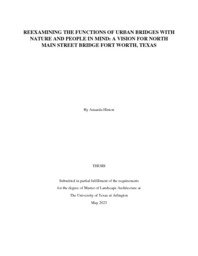| dc.description.abstract | How can nature be incorporated into infrastructure bridges to promote connections in urban landscapes? The Paddock Viaduct, known today as the North Main Street Bridge in Fort Worth, Texas was formally opened on July 3, 1914. Designed by Brenneke and Fay to improve transportation to the North Fort Worth district, the bridge was the first reinforced concrete arch bridge in the nation to use self-supporting reinforcing steel and ball and socket joints (Paddock Viaduct - Main - Historic Fort Worth, 2017).
Fort Worth in the mid-1900s, like many growing cities, was experiencing the repercussions of heavy flooding issues that come when a city’s infrastructure expands beyond the capacity of its local river corridor’s ability to process excess stormwater runoff. Federal funding was used in hopes of strengthening the Trinity River’s levees by straightening the Clear Fork and West Fork of the Trinity. Through this process, the natural meandering flow of the river was replaced by a channel system. Thousands of trees that lived in the escarpment banks were wiped out, and the levees became barriers that kept both flood waters at bay and people away (Panther Island - Central City Flood Project, 2022). With the influence of the “Halprin Plan” and the creation of the Trinity River Master Plan (Confluence: The Trinity River Strategic Master Plan, 2018), steps have begun to be taken to mitigate damage caused to the local ecosystem and continuous flooding hazards.
The purpose of this thesis research is to re-examine the functions of urban bridges to blend nature, people, and vehicles while illustrating a vision by designing North Main Street infrastructure bridge along the Trinity River Corridor at Panther Island, Fort Worth, Texas. The goal is to investigate how the structure can be improved to be a vital connection and an extension of nature to strengthen the relationship of both people and urban landscapes across the Trinity’s levee. This research studies how a conventional infrastructure bridge can be improved to support nature while being a functional amenity to people and vehicles.
This research uses qualitative techniques to explore the research questions in this master design thesis (Sommer & Sommer, 2002; Deming & Swaffileld, 2011). The methodology consists of using People Places approach of examining case studies nationwide to analyze the success of the design elements implemented in the increasingly popular deck parks and plazas such as Salesforce Park in San Francisco, California (Francis & Marcus, 1998). By analyzing the effects of crossings and bridges built for wildlife that have been implemented in an urban setting, we can similarly analyze the benefits of improving the North Main Street bridge along the Trinity River corridor that connects downtown Fort Worth, Texas to the master planned Panther Island district. The research findings demonstrate the positive impacts associated with reconnecting fragmented communities that were in some way separated before. The findings and literature also reveal the beneficial effects of incorporating more natural elements into a design and into urban areas. By combining these, the research shows the added potential a space like these can create recreationally with amenities for the communities.
In conclusion, the historical significance of the North Main Street Bridge in Fort Worth, Texas, should not be understated - it was an innovative engineering feat that played a crucial role in improving transportation for the region. However, as we look to preserve its historical design, we must also ask ourselves how we can incorporate nature into similar infrastructure projects to promote sustainability, connectivity, and community in urban landscapes. By exploring the potential of the design elements retrieved from the research, blending a design seamlessly with the natural environment creates infrastructure that is not only functional but also enhances the quality of life for all those who use it. This research demonstrates how integrating natural elements into design projects, such as bridges in urban landscapes, can enhance connectivity for both pedestrians and vehicles. By proposing a redesign and enhancement of the North Main Street Bridge in Fort Worth, Texas, this study highlights the potential of incorporating multimodal access to create a more cohesive and sustainable urban environment. | |


